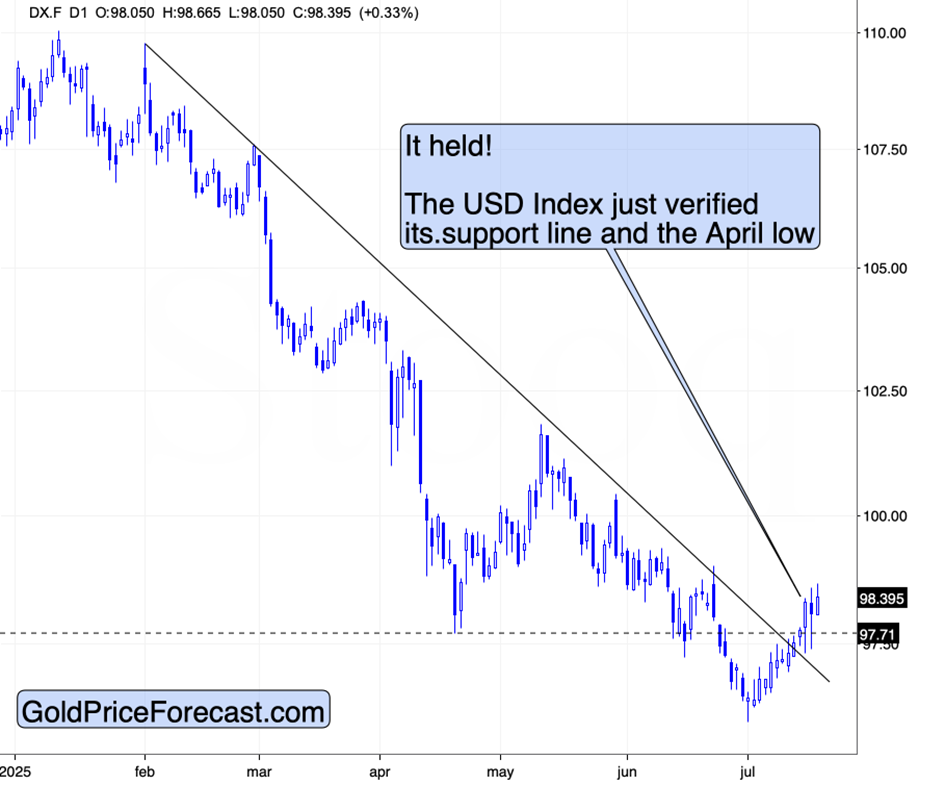The holding pattern of the USD Index offers profound consequences for investors in mining stocks, marking a pivotal moment in the financial landscape. The recent developments have shown that despite a temporary downturn, the USD Index’s breakout stance has not only held firm but has also signified a rebound, unsettling gold prices in the process. This movement, although it may have appeared haphazard to onlookers, is, from an analytical perspective, a strategic manoeuvre of the markets, reflecting a verification of a breakout at its finest.
This phenomenon highlights a key financial principle: the resilience of the USD against bearish pressures. It depicts a scenario where a notable intraday volatility — significant enough to capture attention — ultimately culminated in the USD Index closing the day almost at par with its opening, and then proceeding to ascend further. This pattern did not happen in isolation but is a part of a broader narrative, one that I have termed the Peak Chaos theory, which posits that the market’s current dynamics are a culmination of brewing developments over the preceding weeks.
The relevance of this conversation escalates when considering the implications of these movements on the mining stock sector. For instance, there has been a discernible divergence between the performance of the US dollar and mining stocks over the past year, with the VanEck Junior Gold Miners ETF (GDXJ) recently showcasing a sideways trading pattern, while the USD Index experienced an upward trajectory. This correlation is critical for investors, as it indicates a brewing adjustment in the mining stocks sector, one that could potentially lead to significant declines, mirroring the ascendancy of the USD Index.
But what has catalysed this sudden shift in the fortunes of the USD Index? The answer lies in tariffs and their fundamental impact on the marketplace. Contrary to what might be expected, tariffs possess an inherently bullish nature for the USD. This is because, in the midst of chaos and uncertainty — which the market has become all too accustomed to — tariffs introduce a level of predictability and stability. As these tariffs are implemented, the ensuing decrease in uncertainty, coupled with the tangible, positive effects beginning to manifest, virtually guarantees a bolstering rally in the USD Index.
This outlook is not only rooted in the mechanics of trade policies but is also reflected in technical analysis, wherein the USD Index has showcased a rejection of decline amidst crises and a push above its declining resistance line. Furthermore, the gold market has not seen new highs since April, and miners are now adjusting to the signals emanated by the USD. In fact, miners seem to be preempting gold in this downward trajectory.
As the landscape evolves, the question arises: are we on the cusp of a larger USD breakout? The technical patterns suggest so, with the USD Index’s successful rally after touching the lower border of the flag pattern indicative of a trend continuation. This movement is not only underpinned by technical factors but is also buoyed by the fundamental shifts stemming from tariff implementations. Traditionally, such economic policies would instil a sense of apprehension; however, the current context reveals a scenario where the fundamental forces are aligning in favour of the USD’s ascendance.
This potential rally in the USD Index is not just a numerical increment; it represents a shift in market sentiment from fear to greed, from instability to confidence. Should this trajectory hold, surpassing the 109 level could become a tangible reality, even in the absence of a major recession. This transformation, from chaos to stability, underlines the fundamental bullish nature of tariffs for the USD and highlights the intricacies of policy impacts on market dynamics.
For mining stock investors, these developments spell a critical juncture. The inverse relationship between the USD Index and mining stocks underscores a looming adjustment phase, potentially driving the GDXJ towards, if not below, its April lows. In this light, for those contemplating capitalising on the anticipated declines, the window of opportunity appears to be narrowing.
In essence, the unfolding scenario is a testament to the complexities of market movements and the multifaceted impacts of economic policies on financial instruments. The resilience of the USD Index amidst evolving market chaos and its implications for mining stocks is a narrative of adaptation, presenting both challenges and opportunities for the astute investor.



